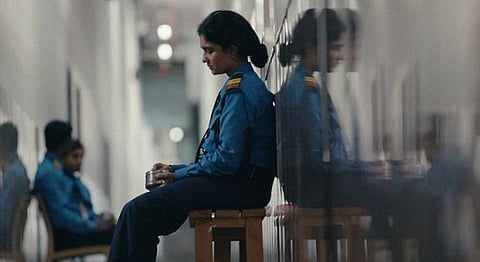
- HOMEGROWN WORLD
- #HGCREATORS
- #HGEXPLORE
- #HGVOICES
- #HGSHOP
- CAREERS
- ABOUT US
- CONTACT US

Our lives, in general, are governed by the spaces we occupy as well as the constant societal gaze that pervades our very existence. The constant surveillance and policing of our bodies, especially those of female bodies can be both suffocating and claustrophobic. It is within this context of policing, claustrophobia and female desire that Rohin Raveendran Nair’s 15-minute short film, The Booth operates.
“The idea of claustrophobia has been a part of my previous short films too – if, in Little Hands, (2017) I explored the idea more as a formal device then in Paijana, (2016) it was thematically one of the main driving forces behind the film. A female frisking booth is a very private space set inside a crowded public space and the juxtaposition of these two thoughts led me to devise this ‘secret’ love story” explains Rohin.
The film revolves around Sargam – a college student played by Parna Pethe and Rekha – a frisking officer played by Amruta Subhash. The frisking booth becomes the centre stage of desire where both the characters interact in unhurried desire thrice a day. The otherwise closeted and claustrophobic space of the booth warrants both the characters the freedom to express their true desires and engage in intimacy away from the public gaze even if it is for a few minutes.
The subjectivity of the artistry behind the film lies in the fact that as a viewer, I perceived the film as a testament of female and queer desire, but Rohin’s approach differs. He tells us, “One of my favourite films has been Ang Lee’s Brokeback Mountain (2005). I never saw it as a gay love story but simply as a love story which evoked so many emotions within me. I approached my short film in a similar fashion and this was one of the first things that I told my two actors as well: that it’s a love story.”
Throughout the short film, we only get a glimpse into a single day of these ordinary characters. The filmmaker, adding to the mystery of the characters as well as warranting some degree of imaginative freedom to the viewer, leaves much to be imagined since he does not give us any backstory to the characters. “I want my viewer to imagine some of the things themselves. My approach is that I’ll just supply the bare essentials to move the narrative. But I am not interested in the characters’ backstories or spoon-feeding my audience. Even during the rehearsals pre-shoot, I told my actors that you are free to imagine your character’s backstory,” he tells us.
Elucidating on the ordinary nature of the characters, he says “There is a good section of people from the LGBTQIA+ community who don’t even know that such terms exist and they are far far away from all the pride marches. I envisioned my two leading characters as coming from such a background who don’t care about these terms and are trying to respond to their natural impulses within the rules and restrictions imposed by the larger society they live in, where the ‘eye’ is always on them or could be on them.” Forcing the audience to think how these two characters came into contact, was it by sheer coincidence, a chance encounter. The mundane nature of their lives drawing one more into their present scenarios. The viewer almost feels compelled to pick up clues and engage with the subtleties, like Rekha’s wedding ring.
There is also a sense of constant surveillance that foreshadows the film — a conscious decision on Rohin’s part that alludes to the safety of the closeted space i.e. the booth and also the fragility of this safety net that can be snipped at any point. “Rekha and Sargam have been able to manage their relationship without getting caught but I wanted to put this idea in my viewer that tomorrow they might get caught. It’s not a they-live-happily-ever-after scenario. We just see a day in their life which save for those fleeting moments when they are together, is mostly spent alone, doing routine, repetitive things and just letting time pass by,” elucidates Rohin.
While one might feel a sense of relief at the characters not being ‘caught in the act,’ you can’t ignore that this might not be the finale. The everyday-ness of the act also adds to the fear of being caught, of being outed to the public gaze, and of your subversiveness being penalised. Rohin leaves us with the parting thought: “I am fascinated by the potential that cinema offers a viewer to imagine a world outside the one they are shown during the duration of the film. At one level, the viewer would be content that Rekha and Sargam were not caught in the end but they cannot ignore the fact that tomorrow could be wholly different and catastrophic for them.”
It is the mystery the characters afford us that makes for a compelling story. The 15-minute-short leaves an impact on you and forces you to think about the characters, about the themes in the film, and the constant policing of bodies and desire. If love is love for all, then why is it only allowed within the closeted space of the booth which is both within the public gaze and away from it? Can human intimacy and female desire only operate in the private, in fleeting moments with the constant threat of being caught?
You can watch the short film, here.
If you enjoyed reading this, we suggest you also read:
